By clicking a retailer link you consent to third-party cookies that track your onward journey. This enables W? to receive an affiliate commission if you make a purchase, which supports our mission to be the UK's consumer champion.
The complete guide to Alexa and Alexa+
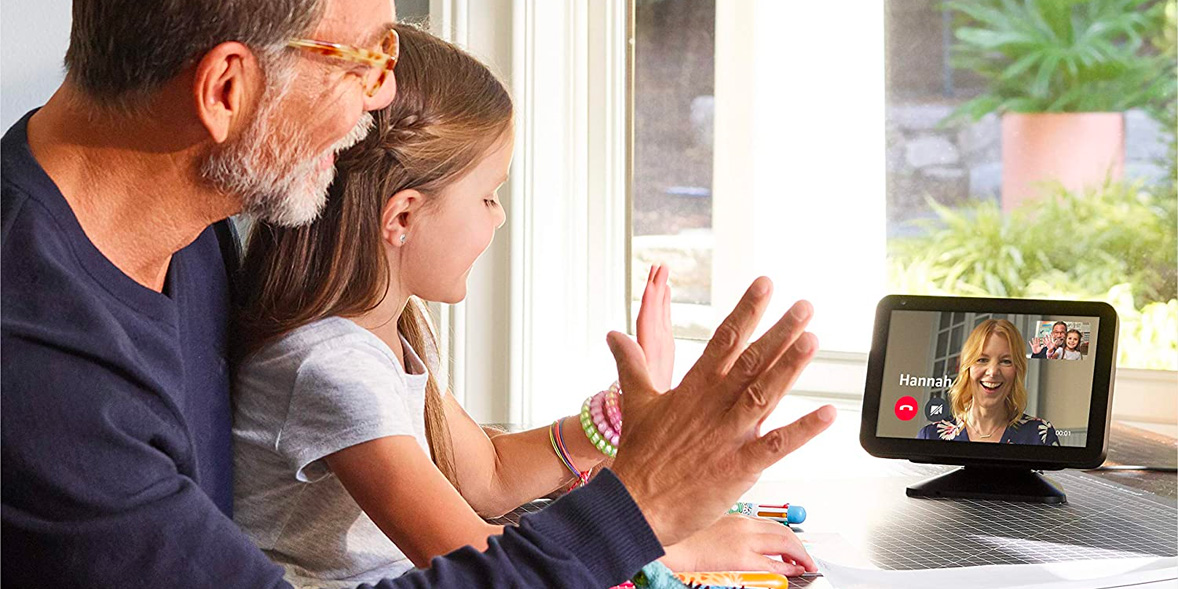
Smart speakers are one of the more engaging ways to embrace the potential of the smart home, allowing you to use voice commands to get answers to questions, access your favourite services and control other smart devices.
Amazon's Echo speakers introduced Alexa to the world and now it's updated version: Alexa+. Our complete guide will help you get the most out of Alexa to assist and entertain, from the choosing the right device to buy, to mastering the voice commands and skills that you'll find most useful on a daily basis.
Browse all our reviews of smart speakers and smart displays to see which impressed in our labs.
Amazon Echo smart speakers
Amazon offers several types of smart speaker:
Prices vary, but bear in mind there are discounts to be had throughout the year. Echos are usually on offer during key sales periods such as Amazon Prime Day and Black Friday.
Echo Pop – designed for voice commands rather than music
If you want an Echo purely to talk to and not hear music, the Echo Pop is your cheapest option. It's tiny and discreet, perfect to nestle away on a bookshelf or bedside table.
Amazon Echo Pop (1st Gen)

We liked Simple to use, good voice control
We didn't like Lacks much volume, music doesn't sound good
As if the Echo Dot wasn't small enough, there's now an Echo Pop. It first came out in 2023 and hasn't been refreshed since. If the Pop has been selling well then we'd expect to see a new version relatively soon.
It's a speaker designed exclusively for voice commands. It can play music, but the speaker isn't good or loud enough. It's fine for hearing Alexa's responses though.
How much should you expect to pay for the Echo Pop?
It's the cheapest option and retails for less £45. As with all Echos, it's often available for less, particularly during Amazon Prime sales events and Black Friday, so wait for those if you're not in a hurry to buy.
For more details on Amazon's smallest speaker speaker, check the full Amazon Echo Pop review.
Echo Dot – for basic audio and voice commands
It's one of the cheapest Amazon Echo devices you can get. It sticks to the basics and sits neatly on a bedside table or a shelf in the living room.
If you don't want to spend a lot and aren't fussed about bass-heavy audio or a touchscreen display, the Echo Dot is a good place to start.
Amazon Echo Dot (5th Gen)
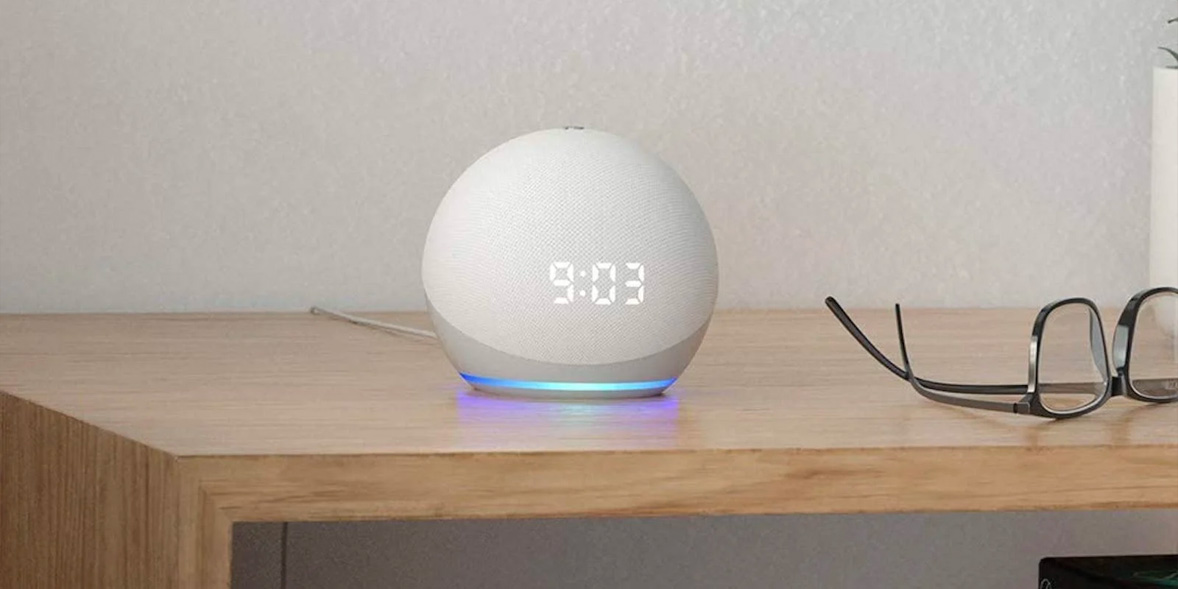
We liked Easy to set up, responsive voice control
We didn't like Bass lacks oomph, maximum volume won't fill larger rooms
The Amazon Echo Dot has had a couple of makeovers over the years – this is the latest model you can get your hands on. The spherical, 4th-generation Echo Dot is powered by the Alexa voice assistant and you'll see a blue ring of light flash around the base of the device when you say the magic 'Alexa' wake word.
There are physical buttons on the top that let you control volume and mute the microphone when you want to send Alexa to sleep. A 3.5mm audio output socket on the back of this Echo Dot lets you connect the speaker to a second, larger speaker. This mini Amazon speaker is available in black, blue or white.
How much should I expect to pay for the Echo Dot?
The full price is £55, but it can often be found on discount at close to around half that.
For more details on this Amazon smart speaker, check in with our full Amazon Echo Dot (5th Gen) review.
Amazon Echo – a happy mix of voice and music
If you like the size of the Echo Dot but want a little more power in the audio department, Amazon is confident the slightly pricier Echo will get the job done.
Amazon Echo (4th Gen)
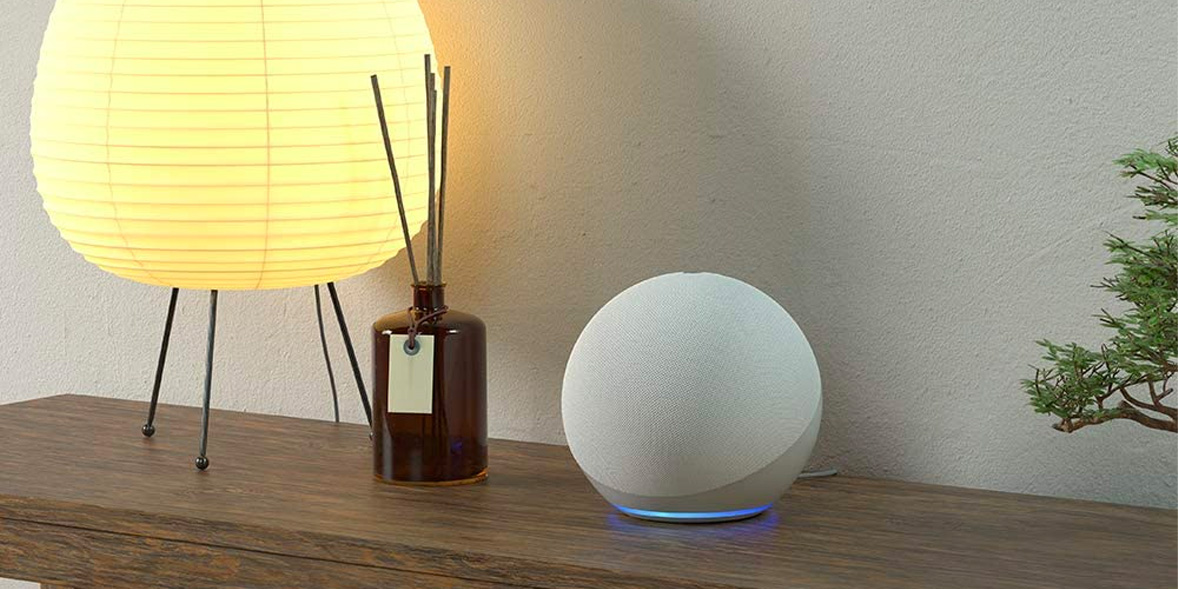
We liked High maximum volume, well built
We didn't like Can't play your own music over wi-fi
Like the Echo Dot, the fourth generation of the Echo swaps out its old cylindrical shape in favour of a spherical design.
Compared with its predecessors, this model has a more powerful maximum volume and now features a built-in smart home hub. This means you have full control over Zigbee-compatible smart home devices you may have set up already, including smart light bulbs.
It appears the 4th gen isn't available, which could mean a 5th generation model is imminent.
How much should I expect to pay for the Echo?
It launched at £110, but we've seen it as low as £60, and we suspect it could even drop a little further during key sales periods.
Amazon Echo smart displays
Amazon Echo Show – smart speakers with screens
If you want to play around with Alexa using a screen, you'll need to buy an Echo Show. There are three models to choose from at the time of writing – Amazon Echo 5 (5.5-inch), Echo Show 8 (8-inch) and Echo Show 10 (10.1-inch).
The Echo Show supports the same basic voice commands that the other Alexa family members do. But with the added bonus of a screen, the Echo Show devices have the potential to be even more useful. Parents can use their Echo Show as a baby monitor, for example, while keen cooks can have an Echo Show in the kitchen and follow recipes on-screen.
Amazon Echo Show 5 (3rd Gen)
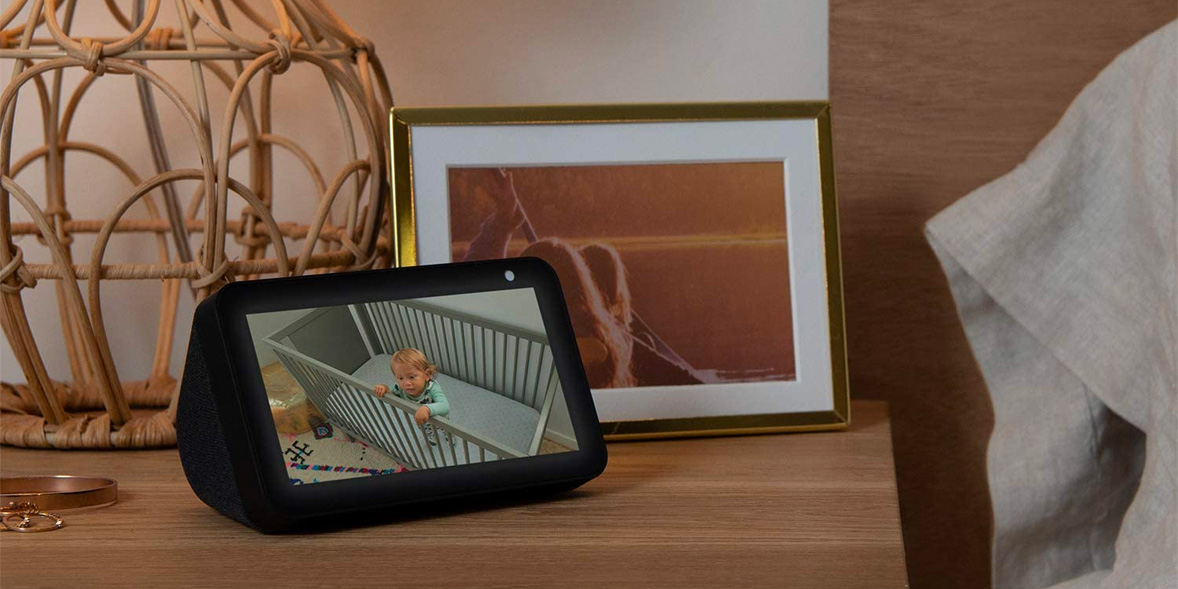
We liked Responsive voice control, sharp display
We didn't like Small screen on this model may be fiddly to use for some
This is the smallest Amazon Echo Show model, featuring a 5.5-inch touchscreen display that lets you interact with the smart products dotted around your house. There are built-in speakers so you can chat with Alexa, along with physical controls that let you control the volume or mute your willing assistant entirely.
Music fans can stream their favourite tunes through supported platforms including Spotify, Amazon Music, Apple Music and TuneIn Radio. Skype calling is also available from the Echo Show 5.
How much should I expect to pay for the Echo Show?
You can expect a reasonable discount. The Echo Show 5 launched at £90, but prices have dropped as low as £40. Similarly, the Echo Show 8, which cost £150 when it came out, has been as cheap as £60 on multiple occasions.
To see how this brainy speaker/display hybrid scored in the Which? test lab, have a read of our full Amazon Echo Show 5 review. If you want a bigger screen, consider the Amazon Echo Show 8.
Amazon Echo Show 15 and 21
In 2024, Amazon introduced even bigger Echo Shows. The screen size is easy enough to remember, the Show 15 has a 15-inch display and the Show 21 has a 21-inch display.
These smart displays are now effectively smart TVs. They don't have aerial inputs, so you can't access broadcast TV, but since they have apps installed, such as Prime Video, you can use them to stream content.
What is Alexa+?

The first iteration of Alexa was around for more than a decade. While in that time it's acquired new skills and many updates its never had an official new version until now.
Here are the key things you need to know:
- Alexa+ will cost money ($19.99 per month in the US and it's not available in the UK yet) or it will be included in your Prime subscription.
- It's not replacing the standard Alexa at the moment and Amazon hasn't said if and when this might happen.
- It has all the same functionality as standard Alexa.
- You can upload files to Alexa+, such as you documents and itineraries, and Alexa+ will be able to summarise them and answer questions based on what's in them.
- It can interact more with websites to buy things and make reservations for you.
- It will work with Alexa-enabled devices, such as Amazon Echos, that you already own.
- It's AI-powered and can remember preferences. The example Amazon uses is for recipes, where Alexa+ knows one family loves pizza while another is gluten-free and it will bear that in mind when making recommendations.
All-in-all, it's a sizeable overhaul to Alexa, but at a cost. Not everyone will need the new features that makes Alexa more of a personal assistant than ever before.
Hopefully the original, free Alexa sticks around for everyone who just wants to execute simple commands, but if Amazon seeks to make more profit from Alexa+ it may switch off its older cousin at some point.
Alexa-compatible devices
Amazon Echo products aside, the Alexa voice assistant is compatible with numerous other devices. The full list includes smart home products such as wireless security cameras, smart light bulbs and even washing machines.
To add a new Alexa product to your home network, or to view all of your smart home devices that run on Alexa, you can open up the Alexa smartphone app (shown below). The Alexa app acts as a home for reminders you've created using voice commands. It also works as a controller so you can switch the lights off without getting off the sofa, or look at a live feed from your wireless security camera.
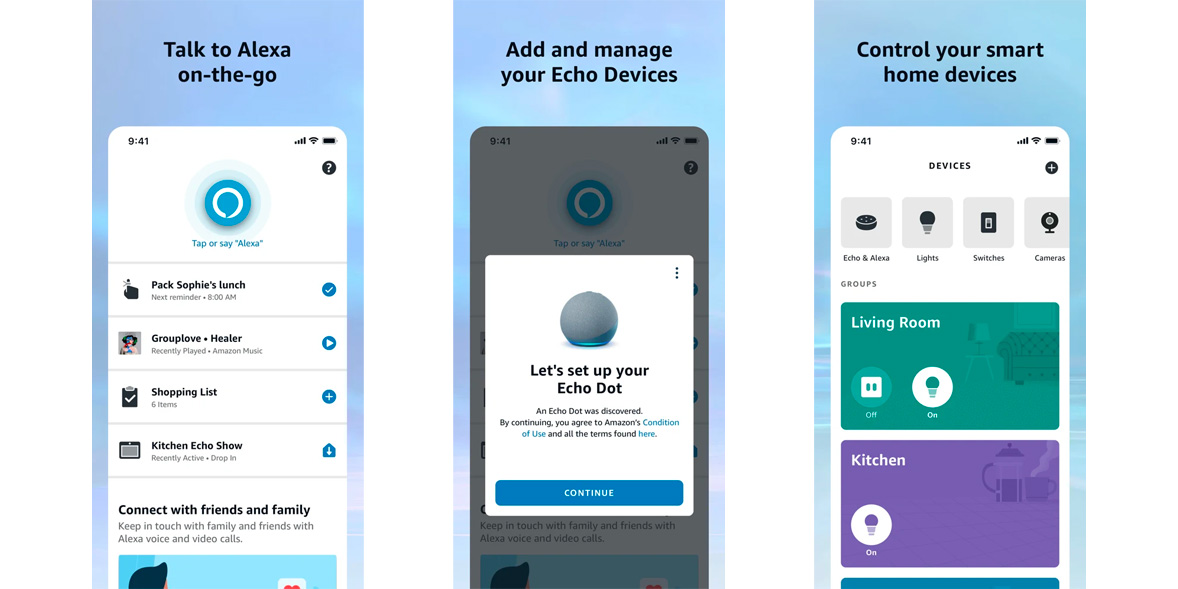
When shopping for new additions to your smart home setup, look for the 'compatible with Alexa' branding. Some internet-enabled products will only work with Apple's Siri or Google Assistant, although most are compatible with more than one AI helper.
How to connect Alexa to wi-fi
If you’re connecting your Alexa device to wi-fi for the first time, for Amazon Echo products and third-party products that are Matter-certified, this is done in the Alexa app. Matter is the latest smart home products standard, launched in late 2022, with updates adding compatibility to many earlier products. Otherwise, head to the specific app for your product.
For a new device, in the Alexa app you first need to add your new device, before then choosing your home wi-fi network and entering your password. It’s recommended to use the same wi-fi network on your Alexa device and device connected to the Alexa app. Amazon Echo devices can connect to wi-fi networks used in most homes (Wi-Fi (2.4 GHz / 5 GHz) networks that use the 802.11a/b/g/n standard). They can’t connect to ad hoc (or peer-to-peer) networks.
If your wi-fi network has changed or you have connectivity issues, you may need to update your wi-fi network to get your Alexa device working again.
For third-party products that aren’t Matter-certified, check the connection in the specific app for that product before checking the Alexa app. If that works, then go into the Alexa app and remove and reactivate the skill for that product in the Alexa app to get it working again. If this doesn’t work, contact your device’s manufacturer.
For Amazon Echo and Matter-certified products, to update the wi-fi connection:
- Open the Alexa app.
- Head to Devices and select your connected device.
- Select the settings Gear icon.
- Under Wi-Fi Network, check the wi-fi network matches the connected wi-fi network on your device running the Alexa app (in Settings for that device).
- If the wi-fi networks don’t match, select Change and follow the instructions. You can also try forgetting the previously connected wi-fi network and then selecting to join another wi-fi network again.
If the problem isn’t fixed, check your router is working by checking the internet is working on another wi-fi device. You can also try checking your Alexa device and Alexa app are running the latest software, and resetting your Alexa device. Here’s Amazon’s troubleshooting page.
How to make any speaker Alexa-compatible
If you'd like to add the Alexa voice assistant to your existing audio setup, there are a couple of ways to do so.
Previously, Amazon sold a device called the Echo Input, which has now been discontinued. The Amazon Echo Input is a small, disc-shaped dongle that you can connect to your audio setup over Bluetooth or using the 3.5mm socket. It was designed for folk who aren't quite ready to wave goodbye to their great, older speakers. If you're desperate to grab one, you'll most likely have to buy a used unit online.
Google's Chromecast Audio was another option at one point, but again that device is no longer on sale.
Nowadays, your best bet is to connect any Amazon Echo Dot to a second speaker by using the 3.5mm audio-in socket. This means you'll get instant access to thousands of voice commands through Alexa, but your audio will come through your larger, second speaker.
Top 10 things to ask Alexa
These are our favourite and most frequently used features and commands:
1. Set a reminder for a time and activity
‘Alexa, remind me to take the bins out tomorrow at 8am.’ You can also set recurring reminders: ‘Remind me every Tuesday at 8am to take the bins out.’ Reminders can be more useful than alarms, since you can tell Alexa what they’re for: ‘Alexa, remind me in 20 minutes to add the sauce’ is more useful than ‘Alexa, set an alarm for 20 minutes’.
2. Build a shopping list
‘Alexa, add milk to my shopping list.’ You can also create new lists through the Alexa app, for example ‘Poundshop’ – then just ask: ‘Alexa, add clingfilm to my Poundshop list.’ You can even now add multiple items at once, and they will appear separately: ‘Alexa, add milk and cheese to my shopping list.’

3. Listen to the radio
‘Alexa, play BBC Radio 1’. Alexa can play dozens of radio stations by default and you can use Alexa Skills to add more.
4. Set a sleep alarm
If you like listening to music or other audio before bed, tell Alexa to set a sleep alarm. It will stop playing automatically so you don’t disturb yourself telling Alexa to ‘stop’. Just say: ‘Alexa, set a sleep alarm for 20 minutes.’
5. What's the weather like?
Most people know you can ask this, but you can also check the weather tomorrow, for the following week or even for a different location. Say ‘Alexa, what’s the weather like in Marseille next week?’

6. Get help planning trips
‘Alexa, how long will it take to get the train to Bristol?’ If you’re wondering what to do at the weekend, get the lay of the land with some approximations from Alexa, without having to look it up.
7. Listen to audiobooks
With a subscription to an audiobook service, Alexa can be the perfect companion for an evening read. For example, ask: ‘Alexa, read Treasure Island from Audible.’ Amazon’s service Audible has a 30-day free trial.
8. Broadcast messages around the home
If you have more than one Alexa device at home, no need to shout to your family – simply use the broadcast feature with the ‘announce’ command to send your message to all the Alexa devices in your home. Say ‘Alexa, announce: takeaway has arrived!’
9. Call friends
If you have an Amazon Echo device (this isn’t supported on all third-party Alexa devices), you can call most UK mobiles and landlines for free once set up in the Alexa app (excluding emergency numbers). ‘Alexa, call Diane.’
10. Get some culinary inspiration
Alexa can give you some easy fresh ideas and even take you through the recipes step by step. ‘Alexa, find quick dinner recipes.’

Voice assistants are an integral part of a smart home, but there’s a wide range of possibilities if you’re looking to invest. Read our guide on how to set up a smart home, including the best smart speakers and household products to buy.
